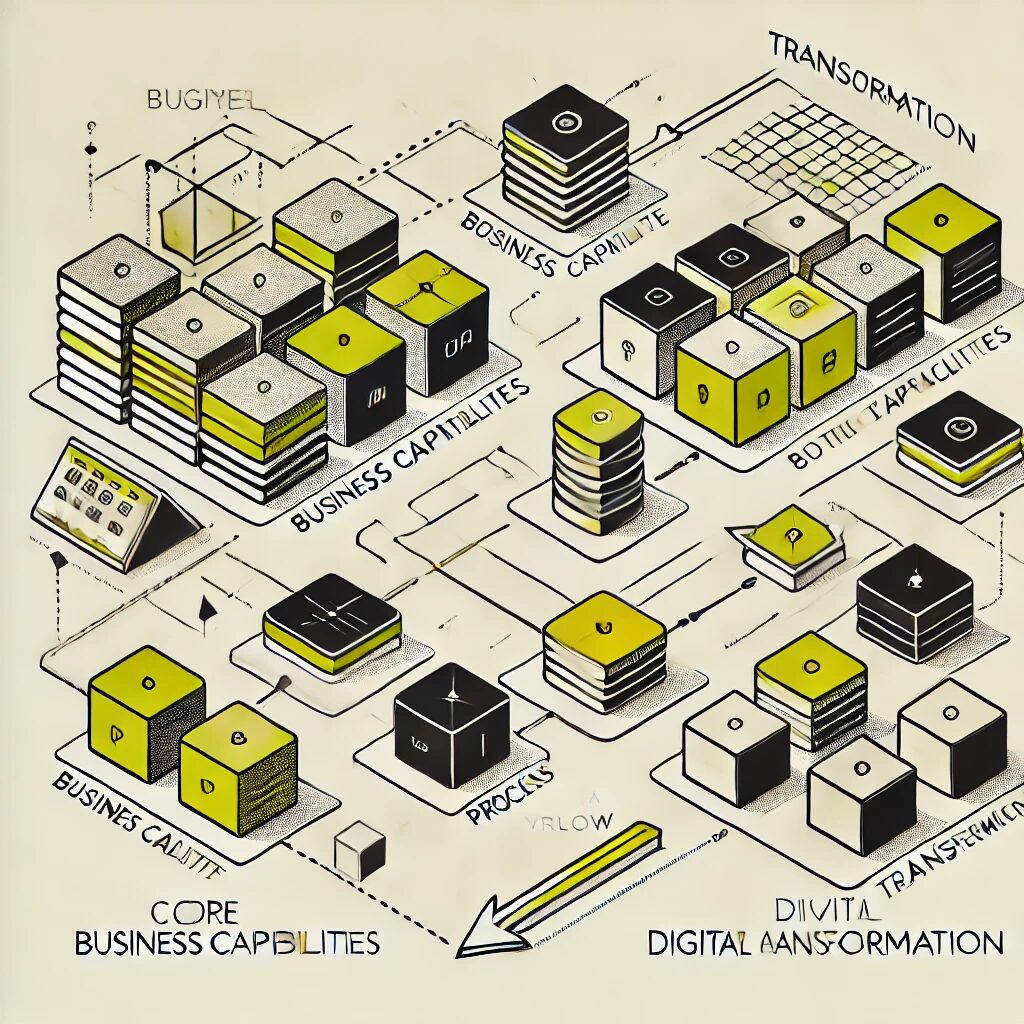
Enterprise Architecture as the Foundation for Real Estate Digital Transformation. Architecting tomorrow’s real estate success in today’s digital landscape
The real estate industry stands at a pivotal crossroads, faced with unprecedented disruption from digital technologies, changing customer expectations, and evolving market dynamics. Traditional approaches to property development, marketing, sales, and management are fundamentally reshaped by digital capabilities, creating existential threats and transformative opportunities.
Enterprise Architecture (EA) provides real estate organizations with the critical foundation needed to navigate this complex digital transformation journey. By creating alignment between business strategy, operational processes, information assets, and technology investments, EA enables real estate firms to transform deliberately rather than reactively, ensuring digital initiatives deliver measurable business value while maintaining operational integrity throughout the transformation process.
1: The Digital Imperative in Real Estate
The real estate industry is experiencing profound digital disruption that is reshaping every aspect of the value chain from property development to customer engagement. Organizations that fail to adapt risk being left behind as digital-native competitors transform market expectations.
- Customer Experience Revolution: Today’s real estate customers demand seamless digital experiences across their entire journey, from property search to transaction completion to ongoing relationship management.
- Operational Efficiency Mandate: Rising costs and competitive pressures require real estate firms to leverage digital technologies for process automation, decision support, and resource optimization.
- Data-Driven Decision Making: The ability to collect, integrate, and analyze data from multiple sources has become essential for market intelligence, portfolio optimization, and strategic planning.
- Ecosystem Integration: Digital platforms are breaking down traditional industry boundaries, creating new partnership models that require sophisticated integration capabilities.
- PropTech Proliferation: The explosion of property technology solutions creates both opportunity and complexity for real estate organizations seeking to modernize their operations.
2: Enterprise Architecture’s Role in Digital Transformation
Enterprise Architecture provides the structural framework that connects business vision to technology implementation, ensuring digital investments deliver maximum business value while maintaining operational coherence.
- Strategic Alignment: EA creates direct traceability between strategic business objectives and digital initiatives, ensuring technology investments directly support organizational priorities.
- Transformation Roadmapping: Architectural analysis provides the foundation for sequencing digital initiatives logically, balancing quick wins with long-term capability building.
- Complexity Management: EA brings order to the chaos of digital transformation by providing clear models of business capabilities, processes, information, and technology landscapes.
- Digital Governance: Architectural standards and principles create guardrails that enable innovation while maintaining enterprise coherence and managing technical debt.
- Change Navigation: EA provides the structural view needed to understand interdependencies across the organization, enabling more effective management of transformation impacts.
3: The Four Domains of Enterprise Architecture in Real Estate
A comprehensive Enterprise Architecture approach addresses four interconnected domains that collectively provide the foundation for digital transformation across the real estate value chain.
- Business Architecture: Documenting capabilities, value streams, organization, and strategic goals creates the business context that drives all other architectural decisions in the real estate organization.
- Information Architecture: Mapping data domains, information flows, and analytical needs establishes how critical real estate information assets will be structured, governed, and leveraged for business insight.
- Application Architecture: Defining application portfolios, integration patterns, and modernization roadmaps creates the blueprint for evolving systems to support digital business models.
- Technology Architecture: Establishing technology standards, infrastructure models, and security frameworks ensures digital solutions are built on a robust, scalable foundation.
4: Business Architecture – The Strategic Foundation
Business Architecture forms the cornerstone of Enterprise Architecture by documenting what the organization does, how it creates value, and how it should evolve to meet strategic objectives.
- Capability Mapping: Documenting core real estate capabilities such as property acquisition, development, marketing, and management creates clarity on what functions must be enhanced through digital transformation.
- Value Stream Analysis: Mapping end-to-end processes like tenant acquisition or property development reveals cross-functional bottlenecks and digital optimization opportunities.
- Business Outcome Alignment: Connecting transformation initiatives to specific business outcomes ensures technology investments directly support strategic objectives.
- Organizational Impact: Business Architecture helps identify how roles, responsibilities, and organizational structures must evolve to leverage new digital capabilities effectively.
- Strategic Performance Measurement: Defining capability-based metrics creates the framework for measuring digital transformation success in terms of business outcomes rather than technical deliverables.
5: Information Architecture – Unlocking Data Value
Information Architecture establishes how real estate organizations structure, govern, and leverage their critical data assets to drive both operational excellence and strategic insight.
- Data Domain Modeling: Classifying and organizing property, customer, financial, and market data domains creates clarity on information ownership, relationships, and governance requirements.
- Master Data Management: Establishing authoritative sources for critical data entities like properties, customers, and locations ensures consistency across the digital ecosystem.
- Analytical Framework: Mapping business questions to data requirements and analytical techniques enables more sophisticated insight generation throughout the real estate lifecycle.
- Data Governance Structure: Defining data quality standards, privacy requirements, and stewardship responsibilities ensures information can be trusted for critical business decisions.
- Information Flow Mapping: Documenting how data moves between systems and processes reveals integration needs and potential bottlenecks in the information supply chain.
Did You Know?
- According to Gartner, real estate organizations with mature Enterprise Architecture practices achieve 25% higher returns on digital investments than those with ad-hoc approaches to architecture.
6: Application Architecture – Modernizing the System Landscape
Application Architecture provides the blueprint for evolving legacy systems toward a more flexible, integrated application portfolio that supports digital business models in real estate.
- Application Portfolio Assessment: Evaluating current systems against business capability requirements reveals gaps, redundancies, and modernization priorities across the technology landscape.
- Integration Architecture: Establishing API strategies, data exchange patterns, and integration standards enables seamless information flow between systems and with external partners.
- Technical Debt Management: Identifying legacy constraints and developing phased modernization approaches balances innovation with operational stability throughout the transformation journey.
- Buy vs. Build Framework: Creating structured evaluation criteria for make-vs-buy decisions ensures consistent, strategic choices about technology procurement and development.
- Cloud Adoption Strategy: Determining which applications should migrate to cloud platforms and in what sequence optimizes both cost efficiency and digital agility.
7: Technology Architecture – Building the Digital Foundation
Technology Architecture establishes the technical standards, infrastructure models, and security frameworks that form the foundation for all digital solutions across the real estate enterprise.
- Infrastructure Modernization: Moving from legacy on-premises infrastructure to more flexible cloud and hybrid models creates the scalability needed for digital business operations.
- Security Architecture: Implementing comprehensive security frameworks protects sensitive real estate and customer data while enabling appropriate information sharing across the ecosystem.
- Technology Standardization: Establishing technical standards reduces complexity, improves integration, and lowers total cost of ownership across the technology landscape.
- DevOps Implementation: Adopting modern software delivery practices accelerates the deployment of digital capabilities while maintaining quality and reliability.
- IoT Integration: Establishing architectural patterns for integrating building systems, sensors, and smart property technologies creates the foundation for intelligent real estate operations.
8: Digital Customer Experience Architecture
Enterprise Architecture provides the framework for delivering seamless, personalized customer experiences across all touchpoints in the real estate journey, from property search to ongoing relationship management.
- Omnichannel Experience Design: Architectural frameworks ensure consistent experiences across physical spaces, mobile applications, web portals, and partner channels throughout the customer journey.
- Customer Data Integration: Establishing unified customer profiles across systems enables personalized experiences based on comprehensive understanding of preferences and history.
- Digital Touchpoint Mapping: Documenting all customer interaction points and their supporting systems reveals integration requirements and experience gaps in the current landscape.
- Self-Service Enablement: Architectural patterns for customer-facing capabilities enable more efficient self-service options for property search, transaction processing, and service requests.
- Experience Measurement: Integrating customer feedback and behavioral data with operational metrics creates a comprehensive view of experience quality and improvement opportunities.
9: Intelligent Operations Architecture
Enterprise Architecture enables the transition from traditional to intelligent operations by connecting operational technologies with business systems and analytical capabilities across the real estate value chain.
- Process Automation: Architectural frameworks for identifying, implementing, and managing automation opportunities ensure consistent approaches to operational efficiency improvement.
- Smart Building Integration: Establishing patterns for connecting building systems, IoT devices, and business applications creates the foundation for data-driven property operations.
- Predictive Maintenance: Architectural models for integrating sensor data with maintenance systems enable more proactive, cost-effective approaches to property management.
- Workflow Optimization: End-to-end process modeling reveals where digital workflows can eliminate manual handoffs and reduce cycle times in key real estate processes.
- Operational Analytics: Creating frameworks for connecting operational data to analytical capabilities enables more sophisticated performance optimization throughout the property lifecycle.
10: Data-Driven Decision Architecture
Enterprise Architecture establishes the foundation for more sophisticated, data-driven decision making across strategic, tactical, and operational levels of the real estate organization.
- Analytical Capability Mapping: Documenting required analytical capabilities from descriptive to prescriptive creates a roadmap for evolving decision support across the organization.
- Data Foundation: Architectural standards for data management ensure decision makers have access to high-quality, consistent information regardless of its source.
- Insight Delivery: Frameworks for delivering analytics through dashboards, reports, and embedded applications ensure insights reach decision makers in actionable formats.
- Advanced Analytics Enablement: Architectural patterns for machine learning and AI implementation create consistent approaches to adopting advanced analytical techniques.
- Decision Process Integration: Mapping analytical capabilities to business processes ensures insights are delivered at the right time and context to influence key decisions.
Did You Know?
- MIT research found that companies with strong Enterprise Architecture capabilities are 38% more likely to successfully execute their digital transformation strategies compared to those without formalized EA practices.
11: PropTech Integration Architecture
Enterprise Architecture provides the framework for strategically incorporating property technology innovations into the overall digital landscape while maintaining enterprise coherence.
- Innovation Management: Architectural governance processes ensure new technologies are evaluated against strategic fit, integration requirements, and total cost of ownership.
- Ecosystem Integration: Establishing standards and patterns for partner integration enables more flexible incorporation of specialized PropTech solutions into the enterprise landscape.
- Vendor Risk Management: Architectural assessment frameworks evaluate technology partners for security, compliance, and operational stability risks before implementation.
- Proof of Concept Methodology: Standardized approaches for testing emerging technologies reduce implementation risk while accelerating innovation adoption.
- Legacy Modernization Synchronization: Architectural roadmapping ensures PropTech adoption aligns with core system modernization to prevent integration complications.
12: Digital Transformation Governance
Enterprise Architecture establishes the governance mechanisms needed to maintain strategic alignment, architectural integrity, and risk management throughout the digital transformation journey.
- Investment Prioritization: Architectural analysis provides the business impact and dependency context needed to sequence digital initiatives optimally across the transformation portfolio.
- Standards Management: Establishing and enforcing technical standards ensures individual projects contribute to rather than complicate the target architecture.
- Architecture Review Process: Structured evaluation of solution designs against enterprise principles maintains architectural integrity while enabling innovation.
- Technical Debt Management: Tracking architectural compromises and establishing remediation plans prevents short-term decisions from creating long-term constraints.
- Digital Risk Management: Architectural assessment identifies security, compliance, and operational risks early in the development process when they can be addressed cost-effectively.
13: Enterprise Architecture Maturity Journey
Developing Enterprise Architecture capabilities in a real estate organization requires a pragmatic, value-focused approach that balances immediate benefits with long-term capability building.
- Baseline Assessment: Evaluating current architectural practices against industry frameworks identifies specific capability gaps and improvement opportunities aligned with business priorities.
- Value-Driven Roadmap: Sequencing architecture capability development to support critical business initiatives ensures immediate relevance and stakeholder support.
- Governance Evolution: Gradually maturing governance processes from initial standards to comprehensive portfolio management prevents bureaucracy while maintaining architectural integrity.
- Team Development: Building architectural capabilities through strategic hiring, training, and engagement models creates sustainable EA practices aligned with organizational culture.
- Tool Selection: Choosing appropriate architecture tools based on organizational needs and maturity supports documentation and analysis without creating excessive overhead.
14: Enterprise Architecture Team Models for Real Estate
Structuring Enterprise Architecture functions effectively requires balancing centralized oversight with distributed execution to drive digital transformation across the real estate organization.
- Federated Architecture Model: Combining centralized EA leadership with distributed architecture roles embedded in business units creates both strategic alignment and local relevance.
- Business Architecture Partnership: Establishing strong connections between Enterprise Architects and business leaders ensures architecture remains focused on business outcomes rather than technical elegance.
- Development Integration: Embedding architectural thinking in agile delivery teams through solution architecture roles maintains standards while enabling rapid implementation.
- Executive Sponsorship: Securing senior leadership support by connecting architecture to strategic business objectives ensures necessary organizational influence.
- Community Building: Creating architecture communities of practice across business and technology domains spreads architectural thinking throughout the organization.
15: Measuring Enterprise Architecture Value
Demonstrating Enterprise Architecture’s contribution to digital transformation success requires connecting architectural activities directly to measurable business outcomes in the real estate context.
- Transformation Acceleration: Measuring how EA reduces time-to-market for digital initiatives through reusable patterns, reference architectures, and decision support.
- Cost Optimization: Tracking savings from reduced redundancy, improved integration, and more efficient technology solutions enabled by architectural governance.
- Risk Reduction: Quantifying how architectural oversight prevents security incidents, compliance violations, and operational disruptions during transformation.
- Strategic Alignment: Measuring the percentage of technology investments directly supporting strategic business capabilities and transformation objectives.
- Business Outcome Contribution: Connecting architectural decisions to specific business improvements in areas like customer experience, operational efficiency, and portfolio performance.
Did You Know?
- A Forrester study revealed that firms with effective Enterprise Architecture governance reduce their IT costs by 18% on average while increasing business agility by 32%.
Takeaway
Enterprise Architecture provides real estate organizations with the essential foundation for successful digital transformation by creating alignment between business strategy, operational processes, information assets, and technology investments. In an industry experiencing profound digital disruption, EA delivers the structural clarity needed to navigate transformation complexity, manage technology risks, and ensure digital investments deliver tangible business value. By establishing a comprehensive view across business, information, application, and technology domains, Enterprise Architecture enables real estate firms to transform deliberately rather than reactively, evolving from traditional operators to digital leaders capable of thriving in an increasingly technology-driven marketplace.
Next Steps
- Conduct an architecture maturity assessment to establish your current baseline and identify specific EA capability gaps impacting digital transformation.
- Develop a high-level business capability map to create clarity on which real estate capabilities most need digital enhancement based on strategic priorities.
- Create an application portfolio inventory connecting systems to business capabilities to identify modernization priorities and integration requirements.
- Establish basic architecture governance including principles, standards, and review processes to guide upcoming digital initiatives.
- Select one strategic transformation initiative where architectural thinking can demonstrate immediate value through improved design decisions and business alignment.
- Build cross-functional architecture awareness through education and engagement with both business and technology stakeholders to create shared understanding of EA’s role in transformation success.



